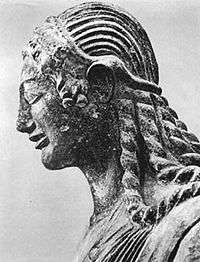Sarcophagus of the Spouses
 | |
| Year | late 6th century BC |
|---|---|
| Type | Terracotta |
| Dimensions | 1.14 m × 1.9 m (3.7 ft × 6.2 ft) |
| Location | National Etruscan Museum, Rome |

The Sarcophagus of the Spouses (Italian: Sarcofago degli Sposi) is a late 6th century BC Etruscan anthropoid sarcophagus, in the National Etruscan Museum of Villa Giulia, Rome. It is 1.14 m high by 1.9 m wide, and is made of terracotta which was once brightly painted.[1] It depicts a married couple reclining at a banquet together in the afterlife and was found in 19th century excavations at the necropolis of Cerveteri (ancient Caere). The portrayal of a married couple sharing a banqueting couch is distinctly an Etruscan style; in contrast, Greek vases depicting banquet scenes reflect the custom that only men attended dinner parties.[1][2]
A similar sarcophagus, also from Cerveteri and often called the Sarcophagus of the Spouses, is in the Louvre in Paris (Cp 5194). There are other Etruscan sarcophagus covers showing couples, but these are the best known.
Description and history
Etruscan culture practiced cremation, so the tomb housed ashes rather than body remains, and women led generally less restricted lives, though they were far from the promiscuous and uncontrolled figures that later Roman writers liked to claim. Unlike in the Greek world, where banquets were reserved for men, the Etruscan woman, who held an important place in society, is represented by her husband's side, in the same proportions and in a similar pose.[3] They are both smiling and have a loving attitude which is very uncommon for Greek culture. Because this is a funerary piece it could mean a positive attitude towards life and death. She is in the process of pouring perfume into his hand, she is making the gesture of offering perfume, another essential component of funerary ritual. In her left hand she is holding a small, round object, possibly a pomegranate, a symbol of immortality.[4]
The smiling faces with their almond-shaped eyes and long braided hair, as well as the shape of the feet of the bed, reveal Greek influence. However, the marked contrast between the high relief busts and the very flattened legs is typically Etruscan. "The Etruscan artist's interest focused on the upper half of the figures, especially on the vibrant faces and gesticulating arms."[1]
References
- 1 2 3 Kleiner, Fred S. (2010). A History of Roman Art, Enhanced Edition, p. xxxi. Wadsworth, Cenage Learning.
- ↑ Fred Kleiner (8 January 2009). Gardner's Art through the Ages: The Western Perspective. Cengage Learning. pp. 179–. ISBN 0-495-57360-4.
- ↑ "The "Sarcophagus of the Spouses" | Louvre Museum | Paris". www.louvre.fr. Retrieved 2015-11-19.
- ↑ "The "Sarcophagus of the Spouses" | Louvre Museum | Paris". www.louvre.fr. Retrieved 2015-11-19.
